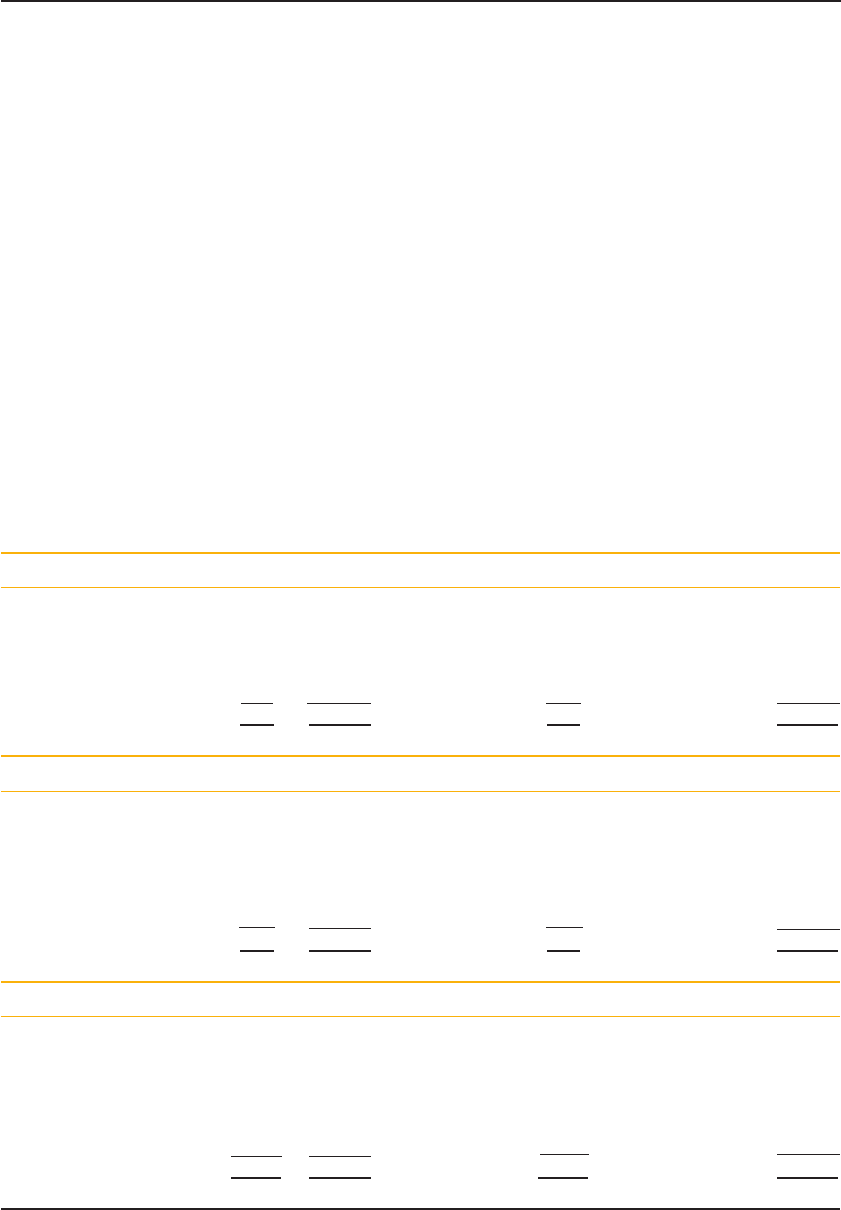CIMA CO1 Official Learning System - Fundamentals of Management Accounting
Подождите немного. Документ загружается.


SPECIFIC ORDER COSTING
SOLUTIONS TO REVISION QUESTIONS C1
240
Work in progress valuation
££
Costs given in question:
Job 1 38,150
Job 2
52,025
90,175
Overhead absorbed:
Job 1 £12,500 350% 43,750
Job 2 £23,000 350% 80,500
124,250
214,425
1.5 Answer: (C)
£
Costs given in question 50,500
Overhead absorbed: £ 4,500 350% 15,750
Total production cost 66,250
Mark up 50% 33,125
Sales value of batch 99,375
Selling price per circuit board
99 375
2 400
,
,
⎛
⎝
⎜
⎜
⎜
⎜
⎞
⎠
⎟
⎟
⎟
⎟
£41.41.
1.6 Answer: (C)
The cost incurred is more than 30 per cent of the total contract cost therefore a
profi t can be recognised on this contract. The maximum amount of profi t that might
be recognised at 30 September is as follows:
£m
Contract value 54
Less:
Costs to date (20)
Future costs (20)
Expected profi t 14
Profi t to be recognised £ 1 4 m ( £ 20 m/ £ 40 m) £ 7 m .
Solution 2
2.1
●
Accounting and taxation services (a)
●
Shoe manufacturing (b)
●
Plumbing and heating repairs (a)
●
Road building (c)
●
Building maintenance and repairs (a) (the cost units are probably of rela-
tively short duration)

SPECIFIC ORDER COSTING
241
FUNDAMENTALS OF MANAGEMENT ACCOUNTING
2.2 (a) £ 45 25% £ 56.25
(b) £ 38 10% £ 41.80 total cost 20% £ 50.16
(c) Note that the margin is expressed as a percentage of selling price:
£75 £88.24
100
85
2.3 False. This is a description of progress payments.
2.4
CONTRACT ZX (extract)
£ £
31 Mar. Plant delivered to contract 40,000 31 Dec. Plant c/d* 32,500
*Depreciation for 9 months
£ £7,50040 000 25
9
12
,%
N
et book value of plant at 31 December £40,000 £7,500 £32,5000
2.5 The revenue to be credited to the company income statement in respect of contract
D372 is £ 512,000. The contract is 80 per cent complete and no problems are fore-
seen, therefore it is acceptable to recognise a profi t on the contract.
Stage of completion cost incurred to date/estimated fi nal contract cost
465,000/581,250 80%
Revenue to be credited to income statement £ 640,000 80% £ 512,000
2.6
●
In this question the profi t is calculated as a percentage of cost. Sometimes the
profi t is expressed as a percentage of selling price so be sure to read the question
carefully.
●
Calculate the total cost fi rst, then the remaining answers can be slotted in as bal-
ancing fi gures.
Job Y256
£
Prime cost 606
Overheads 694
Total cost 1 690
100
130
,
⎛
⎝
⎜
⎜
⎜
⎞
⎠
⎟
⎟
⎟
1,300
Profi t margin 390
Selling price 1,690
2.7 False . A contract loss should be allowed for in the accounts as soon as it is foreseen.
2.8 The estimated labour cost of job no. D47 is £ 1,375.
Workings:
The idle time would be stated as a percentage of the paid labour hours.
Hours
Active labour hours required 120
Idle time ( 4/96) 5
Total paid hours required 125
Labour cost @ £ 11 per hour £ 1,375

SPECIFIC ORDER COSTING
SOLUTIONS TO REVISION QUESTIONS C1
242
Solution 3
●
You will need to recognise that some costs are fi xed and others are variable – note that
you cannot simply double the cost of 10,000 leafl ets to obtain the cost for 20,000.
●
In part (b), not all the capacity is utilised and consequently there is an under-absorption
of fi xed overheads.
(a) (i) £ 64
(ii) £ 53
Workings: Cost of batch 10,000 leafl ets Cost of batch 20,000 leafl ets
££
Artwork
1
65.00 65.00
Machine setting
1
88.00 88.00
Paper 125.00 250.00
Ink and consumables 40.00 80.00
Printers ’ wages 32.00 64.00
350.00 547.00
General fi xed overheads
2
100.00 200.00
Total cost 450.00 747.00
Profi t
30
70
cost
⎛
⎝
⎜
⎜
⎜
⎞
⎠
⎟
⎟
⎟
192.86 320.14
Sales revenue required 642.86 1,067.14
Selling price per 1,000 £64.00 £53.00
Notes:
1. Machine setting and artwork costs are not affected by the size of the batch.
2. General fi xed overhead £ 15,000/600 £ 25 per hour.
(b) (i) General fi xed overhead for the period was under-absorbed.
Actual labour hours worked (64 4 hours) (36 8 hours) 544 hours.
This is less than the budgeted labour hours of 600 and all costs were as expected
therefore the overhead would be under-absorbed.
(ii) Overhead absorbed 544 hours £25 £13,600
Overhead incurred £15,000
Under-absorbed overhead £1,400
Solution 4
●
You will need to produce a lot of workings. These will be for your own benefi t because
workings do not earn marks in the assessment.
●
Note that contract B has been in operation for only 4 months.
(a) (i) £ 880,000
(ii) £ 144,000

SPECIFIC ORDER COSTING
243
FUNDAMENTALS OF MANAGEMENT ACCOUNTING
Workings:
Contract A Contract B
£ 000 £ 000
Plant sent to site 1,000 150
Depreciation
(12%) 120
12%
4
12
⎛
⎝
⎜
⎜
⎜
⎞
⎠
⎟
⎟
⎟
6
Net book value 880 144
(b) (i) £ 505,000
(ii) £ 145,000
Workings:
Contract A Contract B
£ 000 £ 000
Materials sent to site 700 150
Materials returned to stores (80) (30)
Materials transferred (40) 40
Materials on site at 31 March (75) (15)
505 145
(c) (i) £ 300,000
(ii) £ 9,000
Workings:
Contract A Contract B
£ 000 £ 000
Contract price 2,000 550
Cost incurred to date (1,200) (406)
Cost to completion (400) (174)
Estimated total contract profi t/(loss) 400 (30)
Recognised 300
1
(30)
2
Notes:
1.
400
1200
1600
⎛
⎝
⎜
⎜
⎜
⎞
⎠
⎟
⎟
⎟
2. The full amount of loss is allowed for.
Contract B
Degree of completion, based on cost incurred 406/580 total cost 70%
£
Revenue to be credited to income statement (£550,000 70%) 385,000
Cost to be charged to income statement (£580,000 70%) (406,000)
Provision for future losses (balancing fi gure) (9,000)
Contract loss (30,000)
This page intentionally left blank

9
Process Costing
This page intentionally left blank

247
9
LEARNING OUTCOMES
After completing this chapter you should be able to:
compare and contrast job, batch, contract and process costing;
prepare ledger accounts for process costing systems.
9.1 Introduction
In this chapter, you will learn about another costing method: process costing. Process cost-
ing is used by organisations where a number of production processes are involved and the
output of one process is the input to a later process, this continuing until the fi nal prod-
uct is completed. Examples of industries where process costing might be applied are food
processing, chemicals and brewing. The fi nal product is said to be homogeneous (i.e., each
unit is identical and cannot be distinguished from another unit) and is usually manufac-
tured for inventory from which sales are made to customers. Unlike job costing, the prod-
uct is not customer specifi c and the range of products available is likely to be limited, but
it is likely that the customer base will be large.
9.2 Process accounts
When using process costing, the process is the collection point for costs incurred. This
means that materials and labour costs will be identifi ed with the particular process to
which they relate. The method is best explained by a simple example.
Process Costing

STUDY MATERIAL C1
248
PROCESS COSTING
Example
During August a processing company incurred the following costs in its three processes:
Process 1 Process 2 Process 3
£££
Direct materials 6,000 4,000 9,000
Direct labour 1,000 2,000 3,000
Direct expenses 2,000 3,000 4,000
Production overhead 1,000 2,000 3,000
The quantities of input and output were as follows:
Process 1 Process 2 Process 3
kg kg kg
Input 500 200 300
Output 500 700 1,000
The input quantities shown above do not include the output from the previous process. The output from process 1
is transferred to process 2, which in turn transfers its output to process 3 which after further processing results in
the fi nal product.
The process accounts will appear as follows:
Process 1
kg £ kg £/kg £
Materials 500 6,000 Output 500 20.00 10,000
Labour 1,000
Expenses 2,000
Overheads
1,000
500 10,000 500 10,000
Process 2
kg £ kg £/kg £
Process 1 500 10,000 Output 700 30.00 21,000
Materials 200 4,000
Labour 2,000
Expenses 3,000
Overheads 2,000
700 21,000 700 21,000
Process 3
kg £ kg £/kg £
Process 2 700 21,000 Output 1,000 40.00 40,000
Materials 300 9,000
Labour 3,000
Expenses 4,000
Overheads 3,000
1,000 40,000 1,000 40,000
You should note the layout of the process account. It is a ledger account with debit and
credit entries, but it is different from fi nancial accounting ledger accounts because it includes
other columns. On the debit side, there is a column for the quantity as well as the values,

249
FUNDAMENTALS OF MANAGEMENT ACCOUNTING
PROCESS COSTING
and on the credit side as well as the quantity column there is a column showing the cost per
unit. The value per unit of output is calculated by dividing the cost by the number of units.
When preparing process accounts, it is important that the quantity columns are com-
pleted fi rst and balanced before attempting to value the units. This example was a simple
one, but as this chapter progresses and introduces more complications you will see why
this technique is recommended.
Note too that the total cost of process 1 is attributed to its output and that this is then
transferred to process 2. This procedure is repeated in process 2. The output from process 3
is fi nished goods.
9.3 Losses in process
The majority of process industries expect there to be a loss in the production process.
A certain amount of loss is expected and therefore unavoidable and this is
referred to in cost accounting terminology as a normal loss .
This loss may occur through evaporation or may be a form of defective production.
The extent of the normal loss may be estimated using past records and experience. As a
loss, the only value that the organisation can derive from it is its scrap value (if it has any).
It is therefore considered good practice to regard the net cost (after deducting any scrap
sale proceeds if applicable) of producing the normal loss as a cost of the process and to
attribute it to the remaining units. The following example of a single process shows how
this is achieved.
The costs of the process are as follows:
Process 1
£
Direct materials 6,000
Direct labour 1,000
Direct expenses 2,000
Production overhead 1,000
The input quantity was 500 kg and the expected or normal loss was 10 per cent of
input. Actual output was 450 kg. The process account would appear as follows:
Process 1
kg £ kg £/kg £
Materials 500 6,000 Output 450 22.22 10,000
Labour 1,000 Normal loss 50 – –
Expenses 2,000
Overheads 1,000
500 10,000 500 10,000
The total costs of the process ( £ 10,000) have been attributed to the output of 450 kg.
This has the effect of increasing the cost per kg of good output to compensate for the cost
of producing the unavoidable normal loss.
